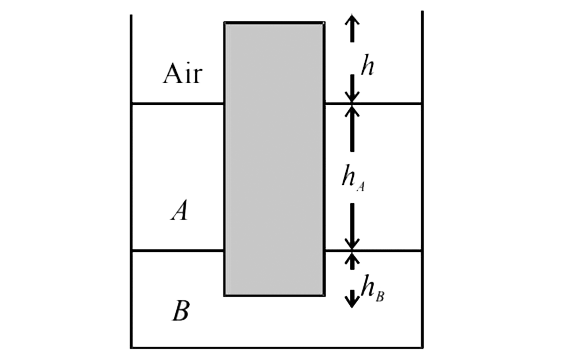Two immiscible of densities 2.5g/cm3 and 0.8g/cm3 are taken in the ratio of their masses as 2:3 respectively find the average density of the liquid conbination.
Let the masses be . 2m . and . 3m. gm respectively . Therefore the volume of the first liquid of density 2.5gm/cm3 is V1=2m2.5cm3
That of tha second liquid is V2=3m0.8cm3
Total volume V=V1+V2=2m2.5+3m0.8cm3
Total mass =2m+3m=5m gm
Therefore, the average density
ρav=5mV=5m2m2.5+3m0.8cm3=1.09gm/cm3
Similar Questions
A beaker contains 262.5cm3 of a certain liquid and weighs 420 g. If the mass of an empty dry beaker is 210 g, find the density of the liquid.
View SolutionTwo discs of same mass and same thickness have densities as 17g/cm3 and 51g/cm3. The ratio of their moment of inertia about their central axes is
View Solution
Knowledge Check
The density of aluminium is 2.7gcm−3 and of brass is 84gcm−3 . For the same mass, the volume of :
Aboth will be sameBaluminium will be less than that of brassCaluminium will be more than that of brassDnothing can be said.
Two solids A and B of density 2.5 g cm−3 and 0.80g cm−3 are placed in a liquid L of density 1.2 g cm−3 Which solid is likely to float and why?
View SolutionDensity of an object is g/cm3. Express it in kg/m3.
View SolutionA body of density 2.5g/cm3 is let free in a liquid of density 1.25g/cm3 . The downward acceleration of the of the body while sinking in the liquid is . _______
View SolutionA uniform solid cylinder of density 0.8g/cm3 floats in equilibrium in a combination of two non-mixing liquids A and B with its axis vertical.
The densities of the liquids A and B are 0.7g/cm3 and 1.2g/cm3, respectively. The height of liquid A is hA=1.2cm. The length of the part of the cylinder immersed in liquid B is hB=0.8cm.

(a) Find the total force exerted by liquid A on the cylinder.
(b) Find h, the length of the part of the cylinder in air.
(c) The cylinder is depressed in such a way that its top surface is just below the upper surface of liquid A and is then released. Find the acceleration of the cylinder immediately after it is released.
View SolutionA uniform solid cylinder of density 0.8g/cm3 floats in equilibrium in a combination of two non-mixing liquids A and B with its axis vertical.
The densities of the liquids A and B are 0.7g/cm3 and 1.2g/cm3, respectively. The height of liquid A is hA=1.2cm. The length of the part of the cylinder immersed in liquid B is hB=0.8cm.

(a) Find the total force exerted by liquid A on the cylinder.
(b) Find h, the length of the part of the cylinder in air.
(c) The cylinder is depressed in such a way that its top surface is just below the upper surface of liquid A and is then released. Find the acceleration of the cylinder immediately after it is released.
View SolutionA uniform solid cylinder of density 0.8g/cm3 floats in equilibrium in a combination of two non-mixing liquids A and B with its axis vertical.
The densities of the liquids A and B are 0.7g/cm3 and 1.2g/cm3, respectively. The height of liquid A is hA=1.2cm. The length of the part of the cylinder immersed in liquid B is hB=0.8cm.

(a) Find the total force exerted by liquid A on the cylinder.
(b) Find h, the length of the part of the cylinder in air.
(c) The cylinder is depressed in such a way that its top surface is just below the upper surface of liquid A and is then released. Find the acceleration of the cylinder immediately after it is released.
View SolutionThe mass of 5 litre of water is 5 kg. Find the density of water in g cm−3
View Solution